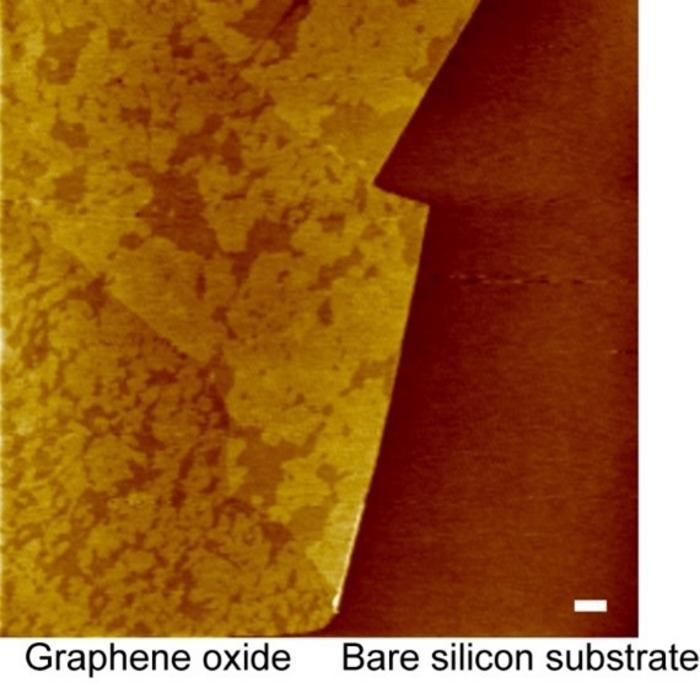A study team (Professor Ryugo Tero et al.) from the Department of Applied Chemistry and Life Science at the Toyohashi University of Technology found a phenomenon in which particular lipids were concentrated on graphene oxide in a multicomponent lipid bilayer membrane acting as a cell membrane model.

Atomic force microscope image of the two-component lipid bilayer formed on the graphene oxide deposited on a silicon substrate. Gel phase domains are concentrated on the graphene oxide (left) and are not observed on the silicon substrate (right). Scalebar: 500 nm. Image Credit: Toyohashi University of Technology
This study group also explained the mechanism through which the constituents of “lipid rafts” (where significant cell membrane reactions like metabolism and neurotransmission happen) gather due to the surface characteristics of graphene oxide. This breakthrough is anticipated to be used in basic technologies for separating and concentrating the lipids and membrane proteins in cell membranes as key research targets in the drug discovery and medicine fields.
Details
Transference of the information, substances, and energy required for life activities both inside and outside of cells is done via cell membranes. Such exchanges are deeply involved in metabolism, neurotransmission, and viral infections, which make them significant research targets in the medicine, biology, and drug discovery fields.
A lipid bilayer membrane is the basic structure of the cell membrane. Certain membrane proteins and lipids gather via the lateral diffusion and aggregation of molecules inside the membrane. Those areas are known as lipid domains, which eventually regulate and enhance the efficiency of the reactions occurring in the cell membrane.
The “lipid raft” is one typical example of the lipid domain, which is rich in cholesterol and sphingolipids. Novel technologies for regulating and organizing the positions of lipid domains on a solid substrate are demanded for the screening and biosensing of membrane proteins and lipids.
This study group made an artificial lipid bilayer on a graphene oxide monolayer deposited on a silicon substrate. They found for the first time that the lipid domains were concentrated on the graphene oxide. Graphene oxide possesses a structure in which hydrophilic oxygen functional groups are included in graphene (a monoatomic sheet material of carbon).
In a two-component lipid bilayer comprising two types of phosphatidylcholines with varied fluidities, most of the low-fluidity gel phase domains in the lipid bilayer membrane are gathered on the graphene oxide. Many lipid raft components existed on the graphene oxide in a three-component mixed lipid bilayer membrane of cholesterols, sphingolipids, and phosphatidylcholine.
Regardless of the lipid composition, the less fluid lipid domains clustered on the graphene oxide. This was owing to the presence of a mixture of hydrophilic and hydrophobic regions on the graphene oxide surface on a nanometer scale. The initial process of the domain formation in the lipid bilayer occurred preferentially in the hydrophobic regions of the graphene oxide.
Professor Ryugo Tero, Research Team Leader, Toyohashi University of Technology
Future Outlook
The research group anticipates that the control of the positions of the lipid domains on the solid substrate is applicable to arrange the membrane proteins using a high affinity for those lipids in the same positions. This breakthrough is valuable for fundamental technologies in the area of biosensing and screening targeting membrane proteins.
In addition, the study group hopes that the same approach can be employed to gather biochemically significant lipid components like glycolipids and the lipid raft. They expect that this will be valuable in the development of techniques for purifying and concentrating membrane proteins and rare lipids in cell membranes.
Journal Reference
Tero, R., et al. (2023). Domain Localization by Graphene Oxide in Supported Lipid Bilayers. International Journal of Molecular Sciences. dx.doi.org/10.3390/ijms24097999.